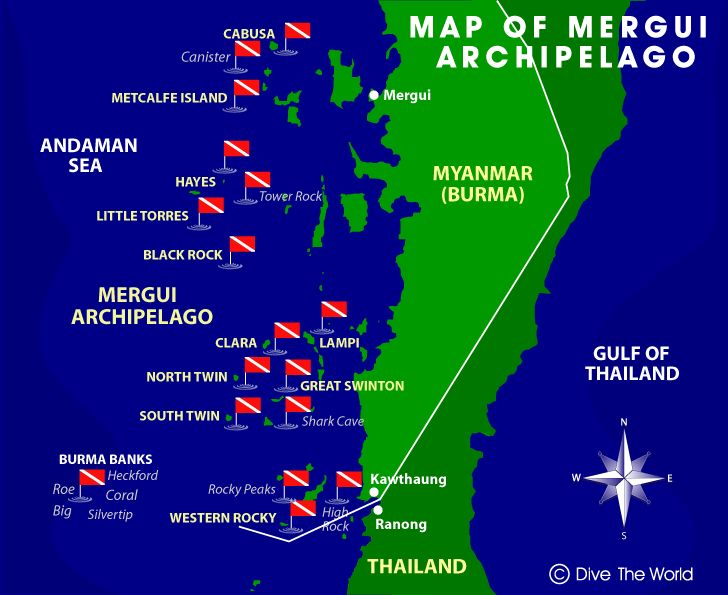-
description :
A rocky islet traversed by two tunnels, one of which is slightly deeper (20 meters) and passes through a cavern. This cavern is the usual haunt of two large nurse sharks. The rest of the dive takes place on the northwest or southwest side, depending on the current. The maximum depth of this site is 30 meters on the northwest side. During our dive, we encountered lionfish, scorpionfish, a large diodon, and schools of surgeonfish, butterflyfish, and coachfish. On a night dive, we also observed two stingrays, two bamboo sharks, and a few crabs, making it an excellent site for night dives.
-
Submarine Rock
rating : 4.0
description :
A small submerged islet situated at approximately ten meters, surrounded by two other small islets at depths of 5 and 24 meters. The passages between these underwater rocks are intriguing, as they are inhabited by a rich variety of reef fish. The south side features a 30-meter drop-off, but local fishermen are also present here, setting nets over twenty meters long and one and a half meters wide between the islets. This necessitates caution when passing between the valleys. During our exploration, we witnessed thousands of small barracudas, each around 15 cm in size, forming a veritable river. The walls, adorned with multicolored coral, were brimming with small moray eels, some in pairs or threes sharing the same cavity. This site is incredibly abundant with marine life, and we also spotted a triggerfish, chestfish, scorpionfish, lionfish, and a group of six lionfish. Additionally, two sea snakes were observed in open water, and a field of anemones covered part of the granite rock, complete with a concentration of cleaner shrimps. We even came across a few nudibranchs.
-
description :
A granite formation with a primary rock standing at approximately 25 meters high, descending to 30-35 meters on the north side and 40 meters on the south side. The south side offers a steep drop-off, while the north side gently slopes down to a sandy bottom. You can swim around it, although you may encounter a strong current at times. This site is home to an incredible number of scorpionfish of all sizes, so extra caution is essential. During our dive, we also encountered a large number of diodons, including a giant specimen measuring over 80 cm, accompanied by two remoras. Two large green moray eels were also spotted. While the marine fauna here is not exceptionally diverse, we did come across a few schools of lyretail anthias and orbicular batfish. The corals are fairly abundant, especially the gorgonians. Moreover, a substantial number of anemones with their white or blue envelopes were present, closing as the light diminished.
-
Moulin Rouge
rating : 3.0
description :
A pinnacle emerges from the water at around 20 meters, forming a rocky mass submerged to a sandy bottom at 26 meters, scattered with numerous potato-shaped rock formations. This site is very rich in fish, especially in the upper twelve meters. During our dive, we encountered schools of coachfish and angelfish, along with a concentration of lionfish, scorpionfish, and groupers.
-
description :
A rocky islet emerging about 20 meters from the surface. Its eastern side features a wall descending to 25 meters, while its western side gently slopes down to a sandy bottom at 30 meters. This site is characterized by an incredible concentration of anemones, where clownfish and juveniles are continually on the move. Additionally, we observed a few nudibranchs, small moray eels, a large pufferfish, and four nicely-sized boxfish.
-
Fanforest Pinnacle
rating : 2.5
description :
An underwater rock submerged at 5 meters and extending to depths of up to 30 meters. In the vicinity, about forty meters away, are several potato-shaped rock formations. On the southwest side, a vertical wall extends from 15 to 30 meters. The corals only cover part of the rocky mass and are relatively small, except for the gorgonians, which are occasionally large and fairly numerous. During our dive, we encountered a large school of small barracudas (30 cm each), an equally large school of rainbow runners (jacks), a stingray, scorpionfish, lionfish, and a large porcupinefish.
-
Western Rocky
rating : 2.5
description :
A rocky islet with an arch about 10 meters high and 4 meters wide on its southwest side, situated at a depth of around 20 meters. This arch permanently shelters a school of lutefish. Next to the arch, at a depth of 20 meters, is the entrance to a cellar where a large grouper seems to stand guard. Inside the cellar, you can observe a multitude of lobsters. The bottom of the cave narrows to form a tunnel approximately ten meters long, leading to the other side of the rock. For those who may feel claustrophobic, it's easy to turn back. A significant part of the islet consists of twenty-meter drop-offs. In some sections of the walls, there are intricate formations, often in the shape of small caves. The site is very rich in fish up to eight or ten meters. During our dive, we encountered four moray eels, including three males vying for the favor of one female. On a subsequent dive at this site, we had the opportunity to witness a white-tip shark passing close to the reef, as well as a school of needlefish just two meters below the surface. This location also offers excellent conditions for night dives.
-
description :
Small rocky islet emerging at around ten meters, with a single tree at its summit. The base of the rock is 18 m deep. The current is very strong in some places, making it difficult to go around it, despite the small size of the rock (around a hundred meters around its perimeter.) A large part of the submerged surface is covered with soft and hard corals, including gorgonians and a few barrels. Seen: a dry reef fish, small moray eels, two or three scorpion fish and a large number of lions. A few schools of reef fish, but difficult to observe due to poor visibility.
-
Mac Carthy Rock
rating : 2.0
description :
A rocky islet with steep walls some twenty meters high. A canyon crosses part of it to the south, where the water is crystal-clear. The canyon is 20 meters deep at the entrance, reaching a depth of five meters towards the end. Very rocky, with few corals. Not much to see below 10 meters, apart from a stingray and a few nudibranchs. Except in the canyon, visibility is poor, with plankton in abundance.
-
description :
A small, square-shaped islet, approximately 100 meters on each side. It is surrounded by six small potatoes up to 25 meters deep. Seahorses permanently nest on the westernmost one. The rest of the dive is similar to the previous two. Corals are not very abundant.
-
Steward Rock
rating : 2.0
description :
Formation of three rocks and a tiny islet linked by passages. A twenty-metre wall rises in its southern part. The relief is interesting, as it is quite rugged and leads to cul-de-sac gorges that must be visited with a torch. Saw a large diodon and a few nudibranchs. Plenty of fish above 10 meters. Soft corals, but not very numerous.
-
Three Sisters
rating : 2.0
description :
On a sandy bottom, a rocky islet emerges. The underwater part is very rugged, with canyons and steep peaks. The flora is small and sparse, no doubt due to the strong current that sweeps along the rock faces. The fauna is limited to a few shoals of juveniles. Saw a few chests and some nice-sized scorpions.
-
description :
Named after a local fish belonging to the scorpion family, visible mainly on night dives. This small rocky islet emerges from the sea at a depth of 24 meters. It's easy to dive around it, sometimes fighting against strong currents. On our dive, visibility was poor. We saw a huge scorpionfish, but otherwise nothing special.





















